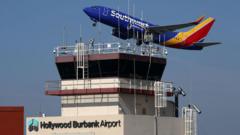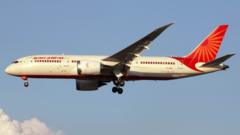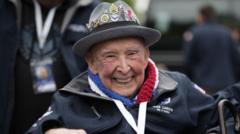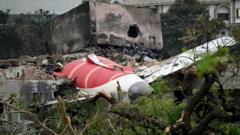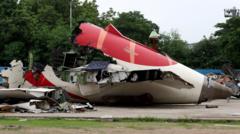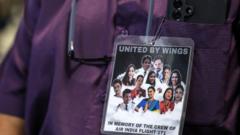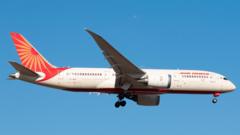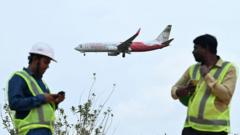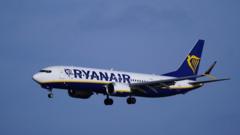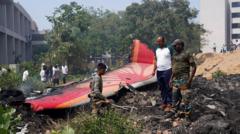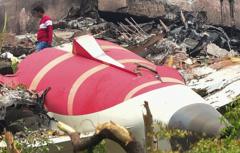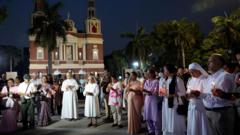A recent collision between a US Army helicopter and an American Airlines jet has raised questions about air traffic management and safety protocols in Washington DC.
**Understanding the Tragic Mid-Air Collision in Washington's Controlled Airspace**
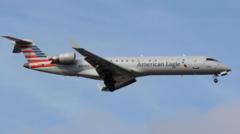
**Understanding the Tragic Mid-Air Collision in Washington's Controlled Airspace**
Experts ponder the circumstances surrounding a mid-air tragedy in one of the world's tightly regulated airspaces.
In a shocking turn of events in what is deemed one of the world's most tightly controlled airspaces, a mid-air collision occurred between a US Army Black Hawk helicopter and an American Airlines passenger jet, resulting in a tragedy that left both aircraft plunging into the icy waters of the Potomac River. The helicopter had three personnel aboard while the jet was transporting 64 passengers, mere seconds from landing at Washington National Airport.
Aviation analyst John Strickland expressed bewilderment at how such an incident could transpire amidst the myriad civilian and military flights that daily navigate the skies above the U.S. capital. With operations including executive transports for high-ranking officials, the complexity of the airspace is notably amplified. John emphasized that despite the challenging nature, the standard traffic management systems in place should ensure flight safety similar to major global cities such as London or New York.
Adding to the premise of complexity, Philip Butterworth-Hayes, an aviation expert, remarked on the convergence of multiple aviation systems—civilian, military, and specific airport protocols—adding layers of difficulty that can potentially lead to mishaps at these critical junctions. This location, which houses vital institutions like the White House and Congress, has historically seen strict regulations intended to enhance safety.
Initial investigations revealed that both aircraft were supposed to maintain contact with air traffic control, a reality underscored by footage showing both vehicles on radar systems readily accessible to controllers. An audio clip captured discussions between the air traffic control team and the helicopter, with instructions to keep a safe distance from the approaching passenger flight. Yet, the reality of a mid-air collision led to immediate follow-up procedures directing other aircraft away from the incident scene.
Both Butterworth-Hayes and retired Air Force Colonel Cedric Leighton pointed out that for a military helicopter to operate within civilian airspace, it must comply with specific identification requirements, including the use of transponders. Given that both aircraft should have been visible to each other and complied with ongoing air traffic instructions, the circumstances surrounding this incident are concerning and warrant thorough analysis.
The Black Hawk was engaged in a routine training exercise with a crew known for their proficiency in navigating the busy airspace of DC, especially during nighttime operations. Former military officials noted that the training was not unusual, serving as a method to sharpen pilot skills under challenging conditions.
As investigations continue, the incident has prompted calls for reassessment of aviation protocols, particularly in U.S. airspace management, to prevent future tragedies. Experts emphasize that accidents like this are infrequent due to stringent safety regulations, hinting that this incident could lead to substantial changes in operational procedures.
In light of the growing concerns for aviation safety, the implications of this collision extend beyond the immediate tragedy, raising questions about the effectiveness of existing safeguards even in what is heralded as the world's most secure airspace.
Aviation analyst John Strickland expressed bewilderment at how such an incident could transpire amidst the myriad civilian and military flights that daily navigate the skies above the U.S. capital. With operations including executive transports for high-ranking officials, the complexity of the airspace is notably amplified. John emphasized that despite the challenging nature, the standard traffic management systems in place should ensure flight safety similar to major global cities such as London or New York.
Adding to the premise of complexity, Philip Butterworth-Hayes, an aviation expert, remarked on the convergence of multiple aviation systems—civilian, military, and specific airport protocols—adding layers of difficulty that can potentially lead to mishaps at these critical junctions. This location, which houses vital institutions like the White House and Congress, has historically seen strict regulations intended to enhance safety.
Initial investigations revealed that both aircraft were supposed to maintain contact with air traffic control, a reality underscored by footage showing both vehicles on radar systems readily accessible to controllers. An audio clip captured discussions between the air traffic control team and the helicopter, with instructions to keep a safe distance from the approaching passenger flight. Yet, the reality of a mid-air collision led to immediate follow-up procedures directing other aircraft away from the incident scene.
Both Butterworth-Hayes and retired Air Force Colonel Cedric Leighton pointed out that for a military helicopter to operate within civilian airspace, it must comply with specific identification requirements, including the use of transponders. Given that both aircraft should have been visible to each other and complied with ongoing air traffic instructions, the circumstances surrounding this incident are concerning and warrant thorough analysis.
The Black Hawk was engaged in a routine training exercise with a crew known for their proficiency in navigating the busy airspace of DC, especially during nighttime operations. Former military officials noted that the training was not unusual, serving as a method to sharpen pilot skills under challenging conditions.
As investigations continue, the incident has prompted calls for reassessment of aviation protocols, particularly in U.S. airspace management, to prevent future tragedies. Experts emphasize that accidents like this are infrequent due to stringent safety regulations, hinting that this incident could lead to substantial changes in operational procedures.
In light of the growing concerns for aviation safety, the implications of this collision extend beyond the immediate tragedy, raising questions about the effectiveness of existing safeguards even in what is heralded as the world's most secure airspace.

